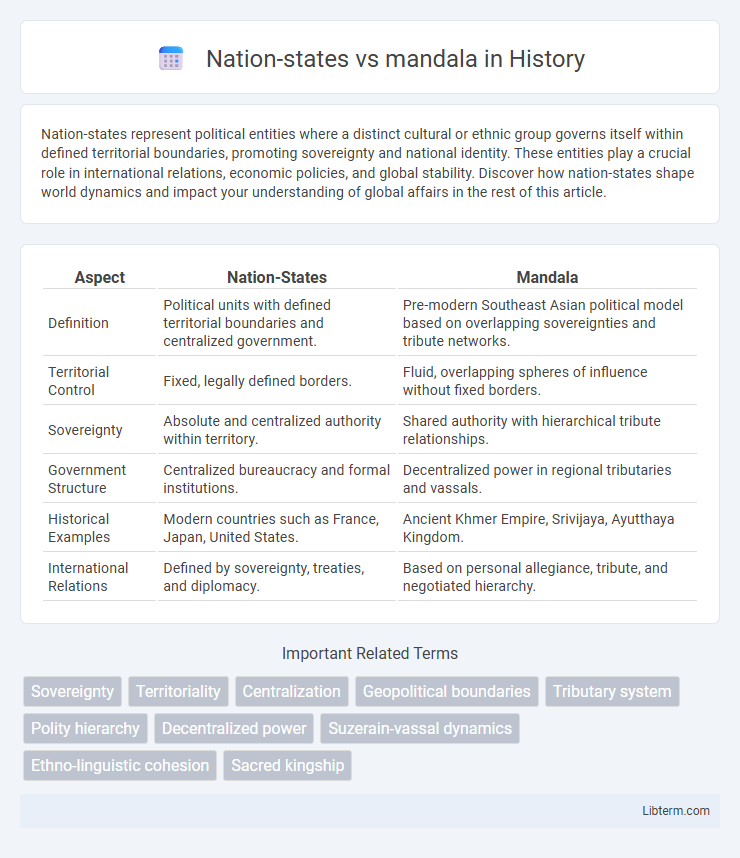Nation-states represent political entities where a distinct cultural or ethnic group governs itself within defined territorial boundaries, promoting sovereignty and national identity. These entities play a crucial role in international relations, economic policies, and global stability. Discover how nation-states shape world dynamics and impact your understanding of global affairs in the rest of this article.
Table of Comparison
| Aspect | Nation-States | Mandala |
|---|---|---|
| Definition | Political units with defined territorial boundaries and centralized government. | Pre-modern Southeast Asian political model based on overlapping sovereignties and tribute networks. |
| Territorial Control | Fixed, legally defined borders. | Fluid, overlapping spheres of influence without fixed borders. |
| Sovereignty | Absolute and centralized authority within territory. | Shared authority with hierarchical tribute relationships. |
| Government Structure | Centralized bureaucracy and formal institutions. | Decentralized power in regional tributaries and vassals. |
| Historical Examples | Modern countries such as France, Japan, United States. | Ancient Khmer Empire, Srivijaya, Ayutthaya Kingdom. |
| International Relations | Defined by sovereignty, treaties, and diplomacy. | Based on personal allegiance, tribute, and negotiated hierarchy. |
Introduction to Nation-States and the Mandala System
Nation-states are defined political entities characterized by defined territorial boundaries, centralized governments, and a unified national identity, promoting sovereignty and legal authority within structured borders. The Mandala System, prevalent in Southeast Asia, consists of loosely organized political units centered around dominant powers without fixed boundaries, where influence depends on tribute and alliances rather than strict territorial control. Understanding the contrast between nation-states and the Mandala System highlights differing approaches to governance, territoriality, and political organization in historical and modern contexts.
Historical Background of the Nation-State Model
The nation-state model emerged prominently in Europe during the 17th century, driven by the Peace of Westphalia in 1648 which established the principles of sovereign territorial states. This framework centralized political authority, defined fixed borders, and promoted national identity tied to language, culture, and legal systems. In contrast, the mandala system in Southeast Asia relied on flexible, overlapping spheres of influence without fixed boundaries, emphasizing personal loyalty and tributary networks rather than territorial sovereignty.
Origins and Principles of the Mandala System
The Mandala system originated in Southeast Asia, characterized by concentric circles of power centered around a ruler whose influence radiated outward to surrounding states through personal alliances rather than fixed territorial boundaries. Unlike the modern nation-state with defined borders and centralized sovereignty, the Mandala emphasized fluid political relationships and overlapping spheres of control based on tribute and kinship. This system prioritized flexible diplomacy and mutual recognition of authority, reflecting a decentralized model of governance rooted in cultural and historical contexts distinct from Western state formation.
Territorial Boundaries: Fixed vs Fluid Concepts
Nation-states are characterized by fixed territorial boundaries defined by international law, creating clear and recognized borders separating sovereign entities. In contrast, the mandala model, prevalent in pre-modern Southeast Asia, features fluid and overlapping boundaries where influence radiates from a central power without rigid territorial demarcations. This contrast reflects differing political organization, with nation-states emphasizing territorial sovereignty and mandalas prioritizing relational power based on center-periphery dynamics.
Sovereignty and Political Authority Compared
Nation-states exercise centralized sovereignty with clearly defined territorial boundaries and a monopoly on legitimate political authority enforced through codified legal systems and institutions. In contrast, mandala polities operate through fluid, overlapping spheres of influence where sovereignty is decentralized, legitimized by personal allegiances and tributary relationships rather than fixed borders. Political authority in mandalas relies on negotiated power dynamics among local rulers, resulting in a flexible hierarchy that contrasts the rigid, centralized governance characteristic of modern nation-states.
Identity, Citizenship, and Loyalties
Nation-states emphasize a unified national identity, citizenship defined by legal frameworks, and loyalties centered on territorial sovereignty and common civic values. Mandala systems feature fluid identities where allegiance is tied to personal relationships and overlapping spheres of influence rather than fixed borders or formal citizenship. Citizenship in mandala structures is often flexible, shaped by kinship ties and negotiated loyalties that transcend rigid national boundaries.
Power Structures and Hierarchical Relations
Nation-states centralize power through defined territorial sovereignty, hierarchical governance, and codified legal systems that emphasize clear authority lines from national to local levels. In contrast, the mandala model features decentralized power with overlapping spheres of influence spread among multiple rulers or chiefs, where authority is negotiated through fluid diplomatic relations rather than rigid hierarchy. This diffusion in mandala structures creates a dynamic web of alliances and tributary ties, contrasting sharply with the fixed, top-down control typical of modern nation-states.
Conflict, Diplomacy, and Inter-State Relations
Nation-states prioritize clearly defined borders and centralized authority, often resulting in rigid conflicts rooted in sovereignty and territorial disputes. Mandala systems emphasize flexible, overlapping spheres of influence through tribute and alliance networks, fostering diplomacy based on personal relationships and negotiated power balances. Inter-state relations in nation-states tend to be formalized and institutionalized, whereas mandalas operate through fluid diplomatic exchanges that accommodate shifting alliances and conflict resolution without fixed boundaries.
Modern Relevance: Mandala in Contemporary Politics
Mandala models offer a nuanced framework for understanding contemporary geopolitical dynamics by emphasizing fluid boundaries and overlapping spheres of influence, contrasting with the fixed borders characteristic of modern nation-states. This approach reveals how states engage in multisided diplomatic networks, reflecting regional interdependencies and power-sharing arrangements prevalent in Southeast Asian politics. Incorporating mandala concepts enhances analysis of regional cooperation mechanisms like ASEAN, highlighting the persistence of pre-Westphalian organizing principles in current international relations.
Conclusion: Lessons and Implications for Global Governance
The contrasting structures of nation-states and mandala systems reveal essential insights for global governance, highlighting the importance of flexible, multi-centered frameworks over rigid territorial sovereignty. Recognizing the fluid, overlapping allegiances in mandala models can inform policies that accommodate diverse cultural ties and economic interdependencies beyond fixed borders. Integrating these lessons supports adaptive governance strategies that enhance cooperation, stability, and responsiveness in an interconnected world.
Nation-states Infographic

 libterm.com
libterm.com